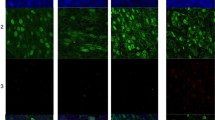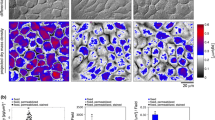Abstract
In order to improve patients’ post-treatment quality of life, a shift from surgery to non-surgical (chemo)radio-treatment is recognized in head and neck oncology. However, about half of HNSCC tumors are resistant to irradiation and an efficient marker of individual tumor radiosensitivity is still missing. We analyzed whether various parameters of DNA double strand break (DSB) repair determined in vitro can predict, prior to clinical treatment initiation, the radiosensitivity of tumors. We compared formation and decrease of γH2AX/53BP1 foci in 48 h after irradiating tumor cell primocultures with 2 Gy of γ-rays. To better understand complex tumor behavior, three different cell type primocultures – CD90−, CD90+, and a mixed culture of these cells – were isolated from 1 clinically radioresistant, 2 radiosensitive, and 4 undetermined HPV–HNSCC tumors and followed separately. While DSB repair was delayed and the number of persisting DSBs increased in the radiosensitive tumors, the results for the radioresistant tumor were similar to cultured normal human skin fibroblasts. Hence, DSB repair kinetics/efficiency may correlate with clinical response to radiotherapy for a subset of HNSCC tumors but the size (and therefore practical relevance) of this subset remains to be determined. The same is true for contribution of different cell type primocultures to tumor radioresistance.
Graphical abstract

Similar content being viewed by others
References
H. Binková, Otorinologie a foniatrie 59, 114 (2010)
Z. Horáková, Otorinologie a foniatrie 59, 107 (2010)
I. Falkova, Zdravotníctvo a Sociálna práca 11, 19 (2016)
F. Perri, Head Neck 37, 763 (2015)
G. Mountzios, Ann. Oncol. 25, 1889 (2014)
W. Han, in Advances in Genetics Research, edited by K.V. Urbano (Nova Science, 2010)
T. Ettl, Oral Oncol. 51, 158 (2015)
G. Peng, Mol. Med. Rep. 10, 1709 (2014)
M. Maalouf, Int. J. Radiat. Oncol. Biol. Phys. 74, 200 (2009)
Q. Wang, Int. J. Cancer 128, 1546 (2011)
T. Kuilman, Genes Dev. 24, 2463 (2010)
A. Lujambio, Bioessays 38, S56 (2016)
L. Ježková, Appl. Radiat. Isot. 83(Pt B), 128 (2014)
M. Falk, Crit. Rev. Eukaryot. Gene Expr. 24, 225 (2014)
J. Sevcik, Cell Signal. 24, 1023 (2012)
J. Sevcik, Cell Signal. 25, 1186 (2013)
A. Affolter, Oncol. Rep. 29, 785 (2013)
X. Ji, Int. J. Clin. Exp. Med. 8, 7002 (2015)
V. Salvatore, Oncotarget 1 (2016)
M. Falk, Appl. Radiat. Isot. 83, 177 (2014)
M. Falk, Biochim. Biophys. Acta 1773, 1534 (2007)
M. Kozubek, Cytometry 45, 1 (2001)
P. Matula, in IEEE International Symposium on Biomedical Imaging: from Nano to Macro 2009 ISBI 09 (2009), p. 1138
M. Svobodova, Oncotarget, 2017, https://doi.org/10.18632/oncotarget.19914
B. Joshua, Head Neck 34, 42 (2012)
M. Falk, Mutat. Res. 704, 88 (2010)
M. Hofer, J. Med. Chem. 59, 3003 (2016)
G. Wolf, Ear Nose Throat J. 80, 897 (2001)
M. Raudenska, Tumour Biol. 36, 9929 (2015)
E. Lukásová, Chromosoma 112, 221 (2004)
E. Lukášová, Biochim. Biophys. Acta 1833, 767 (2013)
Author information
Authors and Affiliations
Corresponding author
Additional information
Contribution to the Topical Issue “Dynamics of Systems at the Nanoscale”, edited by Andrey Solov’yov and Andrei Korol.
Rights and permissions
About this article
Cite this article
Falk, M., Horakova, Z., Svobodova, M. et al. γH2AX/53BP1 foci as a potential pre-treatment marker of HNSCC tumors radiosensitivity – preliminary methodological study and discussion. Eur. Phys. J. D 71, 241 (2017). https://doi.org/10.1140/epjd/e2017-80073-2
Received:
Revised:
Published:
DOI: https://doi.org/10.1140/epjd/e2017-80073-2




